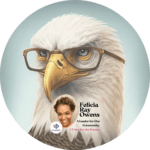
How Scientists Can Be Good Citizens
May 4, 2025
The Ballad of Big Gretch
May 4, 2025The late Carol Downer was an activist, leader, visionary—and, above all, a self-helper.
I found myself looking into the woman’s vagina, which was held open by a plastic speculum, and I saw her beautiful pink cervix, the opening to the uterus. … I was transfixed, looking at her rosy, knob-like cervix with a tiny opening. … I had six children at this time, and I had never looked carefully at my genitals I marveled at how close the cervix is; how simple it is and how accessible it is with the use of an inexpensive, plastic speculum.
—CAROL DOWNER, ‘ON THE ISSUES,’ OCT. 26, 2011
One of the founders of the women’s health movement, Carol Downer died on Jan. 13, 2025, at 91. Before the Supreme Court decided Roe v. Wade, she sparked the feminist self-help movement and helped to develop and popularize menstrual extraction.
Cervical self-exam was revolutionary in the early 1970s, a time when doctors “knew best,” and they were almost always men. The new approach to women’s health—learning together through sharing body knowledge—changed the lives of millions of women who felt differently about themselves after seeing their cervix. Today, when 12 states have total abortion bans, menstrual extraction is one of the strategies pregnant women can use to control their lives. (Per Women’s Health Specialists, the training for the procedure takes at least a few months and up to a year before it can be safely attempted.)
Downer was born in Shawnee, Okla., and like many born in the 1930s, she was challenged by lack of control over her own reproduction. She had to drop out of college after her first year at UCLA when she became pregnant and got married. Four children later and in the midst of a separation, Downer found herself pregnant again with a different partner and decided to seek an abortion. She was able to get a safe abortion, but it was an “excruciatingly painful one because no anesthetic could be given,” she told an interviewer with Veteran Feminists of America in 2021. “You had to be able to get up off that table and run out if you were raided.”
If we don’t learn about our own bodies, somebody else is going to be in charge of what happens to us. It’s just that simple.
Carol Downer
Inspired by the emerging women’s movement and motivated by her own abortion experience, in 1969 Downer joined the abortion task force of Los Angeles NOW. The task force rallied support for Harvey Karman, an illegal abortion provider. Karman, who was not a physician, was using what was then a new and safer method of abortion. Curious about how the handheld syringe and cannula device worked, Downer began observing Karman. She viewed a cervix for the very first time—and what she saw changed her life.
Convinced they could do abortions just as safely as a man, in April 1971 Downer and another task force member organized a meeting to recruit others. When Downer began explaining the abortion device, she realized women “were aghast” at the thought of nondoctors doing abortions. On the spur of the moment, Downer decided to show them her cervix so they could see how easy it would be to insert a cannula. The group responded with curiosity and delight, asking questions and sharing their own experiences.
Downer shared her cervix hoping to convince others that laywomen could do abortions safely. She experienced something much more profound, saying later, “I was imparting my knowledge to them, and they shared their knowledge, and suddenly we were creating new knowledge based on our experiences and observation.”
From there, women’s self-help took off. New group member Lorraine Rothman modified Karman’s hand-held syringe with clear plastic tubing and a one-way bypass valve to prevent air from being pushed into the uterus, minimizing the risk of complications. She named it the Del-Em. They began using the term menstrual extraction, purposely blurring the boundaries between an early abortion and extracting a period. Downer and Rothman received so many invitations to share self-help methods that they traveled to 23 cities, riding Greyhound buses with boxes of speculums labeled “toys.” Back in L.A., the group coalesced and started offering a self-help clinic. This was not designed to be a medical clinic, but an opportunity for women to come together, learn and explore. And then they were busted.
Facing misdemeanor charges of practicing medicine without a license for helping a woman insert yogurt into her vagina to treat a yeast infection, Downer chose to go to trial and argue that women have the right to share knowledge and advice. She was supported by nationally known figures, including Ms. cofounder Gloria Steinem, anthropologist Margaret Mead and antiwar pediatrician Dr. Benjamin Spock. After a five-day trial in December 1972, Downer was acquitted by the jury. Self-help and menstrual extraction continued to spread, in part due to the national publicity generated by the trial.
After Roe v. Wade was announced in January 1973, the group quickly opened the Women’s Choice Clinic in Los Angeles—later renamed the Los Angeles Feminist Women’s Health Center (FWHC). A physician did the abortions. The self-helpers created an alternative model of medical care to provide contraception, lesbian healthcare and general well-woman services, emphasizing respect for women’s choices and involving women in their care as much as possible.
Women-controlled clinics sprang up around the country, including Feminist Women’s Health Centers in Atlanta; Detroit; Portland, Ore.; Tallahassee, Fla.; Washington state; and several locations in California. Women embraced the clinics, and services expanded, eventually including trans folks, and in some sites, donor insemination, prenatal care, childbirth and adoption. Several FWHCs banded together to create the Federation of Feminist Women’s Health Centers to share the cost of promoting self-help and menstrual extraction outside the clinic setting, including leading workshops in foreign countries. For several years, Downer was part of the group of FWHC staffers who wrote books, including A New View of a Woman’s Body: A Fully Illustrated Guide.
The Los Angeles FWHC closed in 1986, the victim of competition from for-profit clinics and a devastating fire the year before. After passing the bar exam in 1991, Downer practiced law, taking disability rights cases, and she worked with the Federation of FWHCs.
Downer’s leadership in the women’s health movement continued even after the Los Angeles clinic closed. She was always willing to support a cause fighting the oppression of women. According to Kwajelyn Jackson, executive director of the Atlanta FWHC, Downer “knew that this country routinely takes care out of people’s hands and puts control into the palms of oppressive systems like patriarchy, capitalism and racism, all with horrible consequences.”
Downer joined other prominent activists to speak out against the war on terror in 2002. She supported campaigns to pressure the Iranian regime to free political prisoners, including feminists Nasrin Sotoudeh and Narges Mohammadi. Downer’s encouragement of women to explore self-help never ended. Katrina Maczen-Cantrell, now executive director of Women’s Health Specialists, remembers learning menstrual extraction in the early 1980s in a group led by Downer. The act of doing a menstrual extraction “was a memorable experience,” she recalls. “We were not helpless … and we did have control of our own reproductive goals.”
Downer continued traveling into her late 80s, giving presentations in the U.S., Canada and Ireland. She collaborated with younger activists and hosted weekly meetings at her home to discuss sexuality, fertility awareness and other topics related to self-help.
When COVID-19 put a pause on travel, Downer threw herself into online activism. Although not at all tech savvy, she understood her website, Women’s Health in Women’s Hands, was the 21st-century version of a flyer announcing a meeting. Through the site, interested people could find their way to a self-help group online or in person. Downer educated herself about changes in the publishing industry and worked with the illustrator of A New View of a Woman’s Body to ensure it would be made available through print-on-demand technology.
In one of her final interviews, Downer told Ms. contributor Carrie N. Baker, “If we don’t learn about our own bodies, somebody else is going to be in charge of what happens to us. It’s just that simple.”
In this post-Dobbs era, Downer’s simple idea still has the power to change the lives of women struggling for control over their own bodies.
This article appears in the Spring 2025 issue of Ms. Join the Ms. community today and you’ll get issues delivered straight to your mailbox.
Great Job Cynthia Pearson & the Team @ Ms. Magazine Source link for sharing this story.







